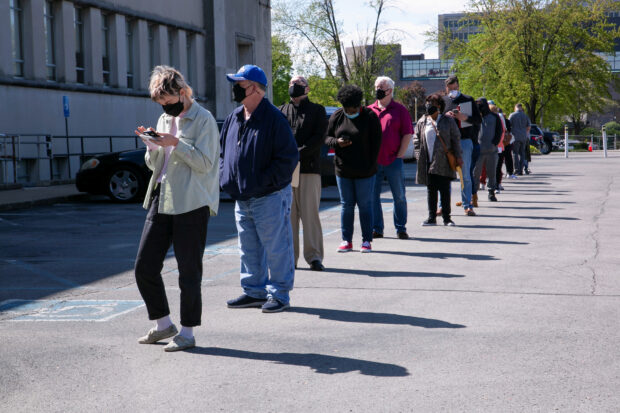US labor market steadily easing as job openings, resignations decline

FILE PHOTO: People line up outside a newly reopened career center for in-person appointments in Louisville, U.S., April 15, 2021. REUTERS/Amira Karaoud/File photo
WASHINGTON — U.S. job openings fell marginally in January, while the number of workers quitting their jobs dropped to a three-year low, indicating that labor market conditions were gradually easing.
The decline in resignations, which pushed the quits rate to the lowest level in 3-1/2 years, over time bodes well for slower wage inflation and overall price pressures in the economy.
READ: US labor market sizzles with blowout job growth, solid wage gains
There were 1.45 jobs for every unemployed person in January up from 1.42 in December, indicating the labor market remains strong. This is well above the average of 1.2 during the year before the COVID-19 pandemic.
The Job Openings and Labor Turnover Survey, or JOLTS report from the Labor Department was published on Wednesday as Federal Reserve Chair Jerome Powell presented the U.S. central bank’s semiannual Monetary Policy Report to lawmakers.
Article continues after this advertisementPowell said policymakers expected “inflation to come down, the economy to keep growing,” but shied away from committing to any timetable for interest rate cuts.
Article continues after this advertisement“The JOLTS data signal that the jobs market is slowly settling down, consistent with wage, and thus inflation, pressures cooling without a worrisome slowdown in net job creation and overall economic activity,” said Sarah House, a senior economist a Wells Fargo in Charlotte, North Carolina.
“The gradual, rather than marked, softening in the labor market will likely keep the Fed comfortable in waiting a little while longer before beginning to cut rates.”
READ: US job openings unexpectedly rise, resignations decreasing
Job openings, a measure of labor demand, slipped 26,000 to 8.863 million on the last day of January, the Labor Department’s Bureau of Labor Statistics said.
Economists polled by Reuters had forecast 8.9 million job openings in January. Job openings peaked at a record 12.182 million in March 2022.
A separate report from the Fed said “labor market tightness eased further,” in February, but noted that “difficulties persisted attracting workers for highly skilled positions.”
Job openings rose in nondurable goods manufacturing, with 82,000 more positions reported. There were also increases in unfilled jobs in financial activities, professional and business services as well as leisure and hospitality industries. But government job openings dropped 105,000.
Government hiring has significantly contributed to payrolls growth in recent months, which had raised worries among some economists that job gains were too concentrated in a handful of sectors. The decline in job openings was in state and local governments.
Private educational services had 41,000 fewer unfilled positions. Vacancies also declined in the retail as well as transportation, warehousing and utilities sectors.
Medium-sized and large businesses accounted for the decrease in overall job openings. Small businesses with one to 49 employees had a large number of vacancies. Job openings dropped in the South, West and Midwest, but increased in the Northeast.
The job openings rate was unchanged at 5.3%. Hiring decreased 100,000 to 5.687 million. There were notable declines in transportation, warehousing and utilities, healthcare and social assistance as well as state and local education sectors.
The hires rate dipped to 3.6% from 3.7% in December. The labor market is gradually slowing following 525 basis points worth of rate hikes from the Fed since March 2022.
Stocks on Wall Street were trading higher. The dollar fell against a basket of currencies. U.S. Treasury prices rose.
Low layoffs
The number of workers resigning from their jobs, presumably in search of greener pastures, dropped 54,000 to 3.385 million, the lowest level since January 2021.
A surge in resignations during and after the pandemic was one of the factors behind robust wage growth.
But as more workers stay put, inflation is cooling, with the ADP National Employment report separately showing on Wednesday that wages for workers remaining in their jobs increased 5.1% in the 12 months through February.
That was the smallest annual gain since August 2021 and followed a 5.3% rise in January.
Fewer workers quit their jobs in the retail sector. There were also significant decreases in quits in healthcare and social assistance as well as professional and business services. But more accommodation and food services workers resigned.
The quits rate, viewed as a measure of labor market confidence, dropped to 2.1%, the lowest since August 2020 and down from 2.2%.
Job cuts were low despite high-profile layoffs at the start of the year. Layoffs dropped 35,000 to 1.572 million in January, keeping the layoffs rate at 1.0% for a third straight month.
The Labor Department is expected to report on Friday that nonfarm payrolls increased by 200,000 jobs in February, according to a Reuters survey. The economy added 353,000 positions in January.
Job growth has cooled from the brisk pace in 2022, but payroll gains are well above the roughly 100,000 jobs needed per month to keep up with growth in the working-age population.
The unemployment rate is forecast unchanged at 3.7% and annual wage growth slowing to 4.4% from 4.5% in January.
“The data are pointing to some rebalancing in supply and demand in the labor market,” said Rubeela Farooqi, chief U.S. economist at High Frequency Economics in White Plains, New York.